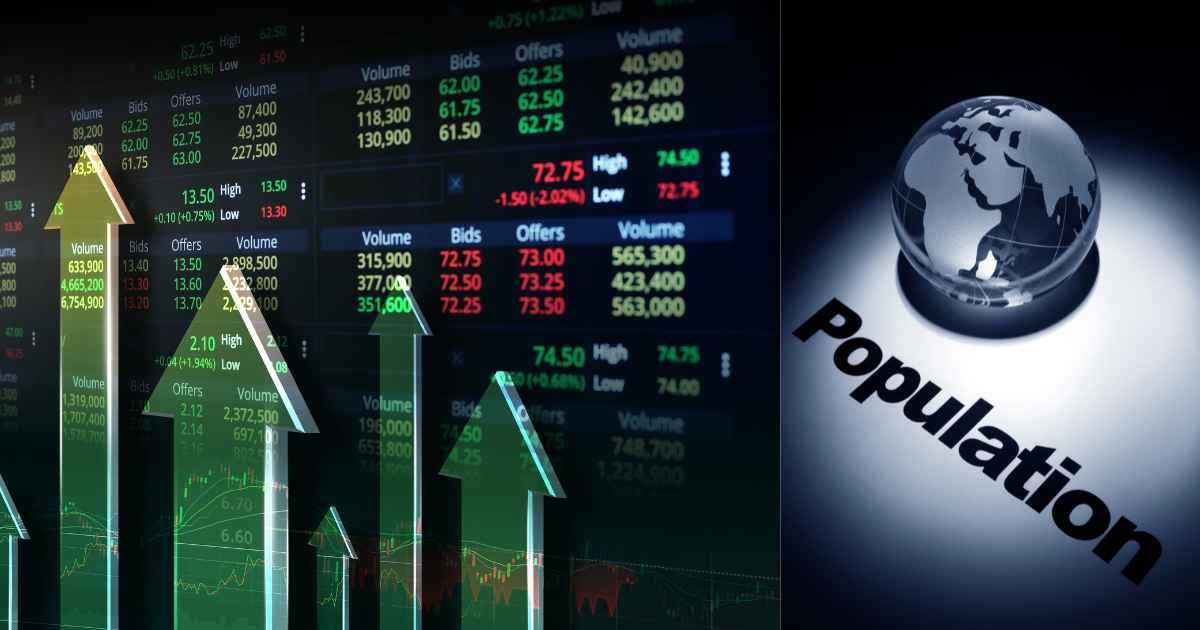Introduction: Two Hidden Currents Shaping Everything
Picture the global economy as a vast ocean. Beneath the surface, two powerful currents move the water: international trade growth and world population growth.
Trade decides how value flows. Population decides where demand rises and labor emerges.
When these currents align, markets expand, ideas travel faster, and living standards lift.
Yet the currents shift. Some regions grow younger and hungrier for goods. Others age and automate.
Supply chains flex, services go digital, and talent follows opportunity.
This report connects both stories, so you can see not just what is happening, but why—and how to act.
Definition: What This Report Means by Trade and Population
International Trade Growth
International trade growth is the increase in cross-border exchange of goods and services over time.
It is measured in value, volume, and composition across sectors.
Growth depends on prices, logistics, policy, technology, and business confidence.
World Population Growth
World population growth is the change in the number of people on Earth.
It is driven by fertility, mortality, migration, and age structures.
Growth patterns differ widely across regions, shaping demand and labor supply.
The Core Link
Population growth creates new consumers and workers.
Trade translates that human momentum into global flows of products, skills, and ideas.
Together, they form a development engine: demand × capability × connectivity.
Origin and Philosophical Background: From Caravans to Cloud
Trade began as trust on footpaths and sea lanes.
The Silk Road moved more than silk: beliefs, techniques, and languages flowed with goods.
Empires rose on tariffs and tolls; ports became cities; cities became networks.
Population followed a different arc.
For centuries, high mortality kept growth modest.
Modern sanitation, medicine, and agriculture unlocked a surge, enlarging markets and workforces.
Philosophically, both forces express the same human impulse: specialize, exchange, and improve.
Trade externalizes cooperation across borders.
Population internalizes it across generations.
Today the caravan is digital and the market is planetary.
Cloud software is the new ship, and data the cargo.
But the old logic remains: more people with more skills, linked by better exchange, create more value.
A Practical Concept: The Trade–Population Engine (TPE)
What TPE Is
The Trade–Population Engine (TPE) is a simple frame to see how demographics and trade co-produce growth.
TPE = People (P) × Productivity (R) × Pathways (C), where:
- P = size and skills of the population.
- R = productivity from tech, capital, and management.
- C = connectivity through trade routes, standards, and trust.
Why TPE Helps
It shows why identical policies yield different outcomes across countries.
A nation rich in people but poor in pathways stays underconnected.
A nation rich in pathways but shrinking in people must automate or import talent.
Using TPE
Ask three questions for any strategy:
- Are we expanding skills and participation?
- Are we raising productivity with tech and process?
- Are our trade pathways diversified, resilient, and trusted?
Real-World Applications Across Sectors
Business and Industry
Companies track demographic heatmaps to allocate capital.
Youthful regions pull in consumer goods, fintech, and entertainment.
Ageing regions tilt demand toward health tech, robotics, and services.
Exporters segment by income bands and urbanization.
Product design shifts with household size, climate, and culture.
Winning firms blend global scale with local fit—modular offerings, localized UX, and adaptive pricing.
Technology and AI
AI relies on data diversity, skilled talent, and compute.
Trade spreads models, chips, and tools across borders, compounding innovation.
Digital services scale faster than physical goods and face fewer logistical frictions.
Population shapes AI demand.
Young users push social, gaming, and creator tools.
Older users drive health monitoring, assistive tech, and secure finance.
Society and Inclusion
Open trade expands variety and lowers prices, which matters most to low-income households.
Population growth tests infrastructure—transit, housing, and utilities.
Balanced policy channels trade gains into public goods that make growth durable.
Migration acts as a pressure valve.
Surplus labor moves to where capital and skills are scarce.
When regulated fairly, it raises productivity and tax bases on both ends.
Design and Product Strategy
Designers map people’s rhythms—work, family, mobility—to build products that travel well.
They use cultural probes and local research partners to avoid one-size-fits-none.
Packaging, instructions, and warranties must be legible across languages and literacy levels.
Education and Skills
Population growth enlarges the classroom; trade enlarges the curriculum.
Cross-border education, micro-credentials, and apprenticeships make skills mobile.
Lifelong learning becomes an economic infrastructure, not a luxury.
Finance and Investment
Investors read TPE as a portfolio compass.
- High-P regions: consumer staples, infrastructure, mobile finance.
- High-R clusters: automation, chips, industrial software.
- High-C hubs: logistics, ports, digital interconnect, standards bodies.
Risk lives in concentration.
Diversifying suppliers, routes, and currencies hedges shocks.
Hedging talent is just as vital—develop local leaders in every growth market.
Public Health and Resilience
Trade moves vaccines, reagents, and devices; population defines need.
Resilient systems pre-qualify suppliers, stock critical parts, and simulate disruptions.
The best health strategies treat data sharing as a public good.
Agriculture and Food Systems
Feeding a larger, urban world needs both yield and logistics.
Sustainable intensification, cold chains, and grain corridors reduce volatility.
Diet shifts with income; trade balances the world’s plate.
Comparison: TPE vs. Protocols and Traditional Models
Traditional Models
Classic trade models isolate prices, comparative advantage, and tariffs.
Demography often sits offstage as an exogenous trend.
These models explain relative costs but miss who buys and who builds.
Protocol-First Thinking
Protocols standardize behavior—payments, customs, labeling.
They reduce friction but can blind decision-makers to demographic realities.
A pristine protocol won’t fix a shrinking labor pool or collapsing demand.
TPE Advantage
TPE fuses people, productivity, and pathways.
It explains why identical tariff cuts yield different growth in different places.
It guides sequencing: train people, then upgrade tech, then expand routes.
Future Implications: Risks, Ethics, and Opportunity
Opportunities
- Services Acceleration: Digital trade scales with modest capital and leaps borders.
- Green Transitions: Clean energy supply chains create new comparative advantages.
- South-South Trade: Growing south-to-south corridors diversify demand.
- City Networks: Megacities trade talent and standards as much as goods.
Risks
- Fragmentation: Bloc politics can splinter standards and platforms.
- Concentration: Overreliance on single suppliers or routes magnifies shocks.
- Skills Mismatch: Fast tech, slow training leaves people behind.
- Ecological Strain: Unsustainable extraction erodes long-term capacity.
Ethics
Fair trade is not just prices—it’s participation.
Design policies to avoid dumping, forced labor, or exploitative terms.
Measure success by inclusion, not only by GDP averages.
Designing for the Topic: Best Practices You Can Apply Now
Build Workforce Capacity First
Invest in foundational and digital skills across the whole population.
Tie curricula to local industry roadmaps and export strategies.
Certify skills in portable formats so workers can move as markets move.
Treat Data as Infrastructure
Create national trade and labor observatories with open dashboards.
Track supplier risk, lead times, and wage trends in near-real time.
Use privacy-preserving analytics to align policy with evidence.
Diversify Everything
Spread suppliers across geographies and tiers.
Qualify alternates before you need them, not during a crisis.
Use dual-sourcing for critical inputs and dual-routing for logistics.
Go Modular and Local-First
Design products in interchangeable modules to localize fast.
Localize content, compliance, and customer support from day one.
Empower regional teams to adapt offers without breaking the brand.
Price for Volatility
Baked-in buffers beat last-minute scrambles.
Use flexible contracts, currency hedges, and indexed pricing.
Build working-capital cushions that survive slow customs or sudden surges.
Green Is Growth
Audit carbon and waste through the supply chain.
Choose low-emission transport and recyclable packaging.
Green finance can lower your capital cost and open premium markets.
Social License Matters
Publish supplier codes and audit outcomes.
Invest in local communities near plants and ports.
Align incentives so ethical practices are rewarded, not penalized.
Sector Playbooks: Turning TPE into Action
Manufacturing
- People: Apprenticeships, technical colleges, safety culture.
- Productivity: Automation for dull, dirty, dangerous tasks.
- Pathways: Multi-port export options; bonded warehouses.
Software and Digital Services
- People: Cloud certs, secure coding, product management.
- Productivity: CI/CD, A/B testing, observability.
- Pathways: Data residency compliance, cross-border billing.
Agriculture and Food
- People: Agronomy extension and cooperative training.
- Productivity: Precision farming, cold-chain, waste reduction.
- Pathways: Regional grain corridors; sanitary-phytosanitary readiness.
H3: Health and Life Sciences
- People: Clinical trials talent, regulatory affairs.
- Productivity: GMP, continuous manufacturing, digital QA.
- Pathways: Fast-track approvals, trusted quality standards.
H3: Education and Skills
- People: Teacher pipelines and ed-tech literacy.
- Productivity: Blended learning, assessment analytics.
- Pathways: Credit transfer, cross-border micro-credentials.
Scenario Planning: Three Plausible Paths
Open Bridges
Trade barriers ease; standards converge; skills rise globally.
Services boom; supply chains gain redundancy; wages climb broadly.
Winners invest early in people and platforms.
Guarded Islands
Tariffs and data walls proliferate.
Goods trade slows; services fragment; duplication raises costs.
Winners hyper-localize supply and monetize reliability.
Twin Tracks
Alliances deepen within blocs, but inter-bloc conduits persist.
Firms run mirrored supply chains and multi-cloud stacks.
Winners master orchestration and real-time switching.
Measurement: What to Track Quarterly
- Population Signals: labor participation, youth cohorts, net migration.
- Productivity Signals: unit output per hour, defect rates, digital adoption.
- Connectivity Signals: supplier concentration, lead times, on-time delivery.
- Resilience Signals: inventory coverage, alternate route readiness.
- Inclusion Signals: wage growth by decile, SME export share, training hours.
Dashboards beat anecdotes.
Pick metrics you can improve, not just admire.
Case-Style Illustrations (Composite, Not Tied to One Country)
Mobile Money Leap
A mid-income nation with a young population lacked bank branches.
By opening telecom rails to fintechs, small merchants got digital wallets.
Trade in services grew, remittances got cheaper, and tax receipts rose.
Dual-Supplier Electronics
An electronics exporter moved from single to dual sourcing of key chips.
Lead-time risk fell, deliveries stabilized, and premium customers paid more for reliability.
Margins improved despite higher unit input costs.
Agri-Cold Chain
A farm belt invested in cold storage and reefer logistics.
Post-harvest losses dropped; exports met stricter safety standards.
Farm incomes rose, and food prices stabilized in urban centers.
Ethical Guardrails for the Next Decade
- Dignity at Work: Safety, fair wages, and credible redress.
- Sustainable Materials: Design for circularity from the start.
- Transparent Claims: Back “green” and “fair” labels with audits.
- Shared Upside: Tie incentives to training and community impact.
Ethics is not a tax on growth.
It is a multiplier—trust widens markets and deepens partnerships.
Conclusion: The Human Meaning of Trade and Population
Trade is how we extend each other’s reach.
Population is how we extend each other’s time.
Together, they are the world’s feedback loop: needs meet skills, and skills create new needs.
If we train people, raise productivity, and keep pathways open, growth becomes compound, fair, and resilient.
If we ignore any one element, the engine misfires.
The choice is ours—design the system that designs our future.
FAQs (Simple Language)
Q1: Why do trade and population growth belong in one report?
Because people create demand and supply, and trade connects both across borders.
Q2: Can a country grow trade with a shrinking population?
Yes, by automating, upskilling, and welcoming needed talent while exporting high-value services.
Q3: Which sectors gain most from young populations?
Consumer goods, fintech, entertainment, education, and entry-level services typically grow fastest.
Q4: What is the safest way to de-risk supply chains?
Qualify multiple suppliers, routes, and currencies, and practice switch-over drills.
Q5: What’s one action I can take this quarter?
Launch a skills + supplier diversification sprint and publish a resilience dashboard.











